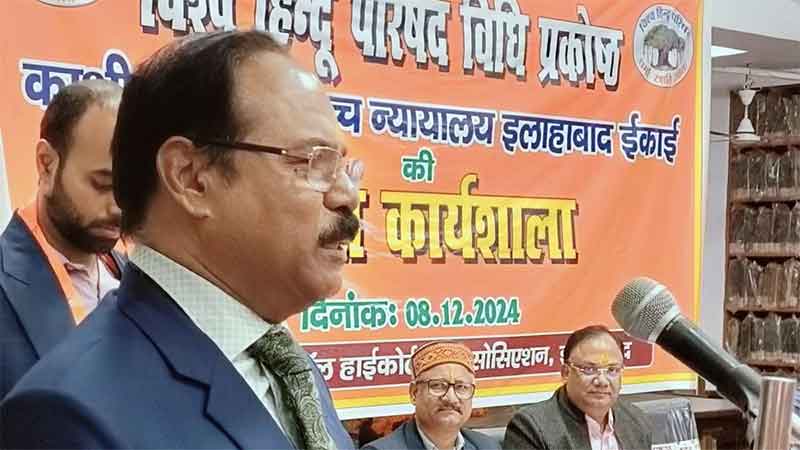Enumeration of different castes and sub-categories of SCs as apart of the current decadal Census exercise, in the context of the Supreme Court’s Judgement on sub-classification within SC categories, should serve as a means to do adequate justice to empower them and also for restoring the Constitutional rights of migrant SC/ST communities

To
Smt Droupadi Murmu
President of India
Rashtrapati-ji,
I refer to a recent announcement made on behalf of the Union Government that caste-wise enumeration would hereafter be a part of the decadal Census exercises to be undertaken by the government (https://www.hindustantimes.com/india-news/caste-data-to-be-part-of-next-population-census-centres-big-announcement-101746010277205.html)Instead of allowing such a decision to remain a statement arising from mere political expediency, it should be read in conjunction with the land-mark judgement pronounced by a Seven-judge Constitution Bench of the Supreme Court on August 1, 2024 on the validity of
sub-classification within Scheduled Caste categories (https://www.hindustantimes.com/india-news/caste-data-to-be-part-of-next-population-census-centres-big-announcement-101746010277205.html), in order to empower those subcategories of the Scheduled Caste individually, and also for restoring the Constitutional rights of all those among both the Scheduled Castes (SCs) and the Scheduled Tribes (STs), who have migrated from their parent States to other States, either as a result of extreme social discrimination or as a result of physical threat, or in search of livelihoods.
Inordinate delay in Census enumeration:
Citing the Covid virus that swept across the country at the beginning of this decade, the Centre chose to take an unprecedented decision to defer the 2021 Census indefinitely, depriving the country of a reliable database of population enumeration for formulating and implementing several important development schemes. A scientifically conducted population enumeration would have helped in authenticating the otherwise questionable Aadhar identity system and setting right the highly deficient system of electoral rolls.
Similar to the Covid crisis, if not more virulent, the Spanish flu of 1918-20 caused the death of 18 million people (roughly 5.6% of the population of India at that time). Even such a devastating virus scourge across the country, when no adequate vaccination facilities were available and when the then available communication facilities were thoroughly inadequate, did not deter the then Registrar General and Census Commissioner of India (RGCCI) from conducting the Census exercise for 1921 right on time, as the government at that time earnestly felt committed to the idea of governance based on hard data.
I would earnestly appeal to your high office to ensure that the present government conducts the much-delayed Census for the current decade without any further delay so that the country may have the benefit of having authentic population data for planning.
Enumeration of sub-categories of the SC population:
As a sequel to the above cited Supreme Court judgement, several States have set up expert committees to take into account the population of different sub-categories of SCs based on the outdated 2011 Census, which did not fully enumerate the sub-categories accurately, as required for the current exercise. In the 2011 Census, while many sub-categories of SCs were covered, it ignored the fact that some sub-categories were known by different names in different regions, though they were subject to the same extent of discrimination and disempowerment across the board. This has resulted in under-estimating their State-wise numbers, which in turn has done inordinate injustice to them in terms of the intent underlying the apex court’s judgement. For example, in Andhra Pradesh (AP), there is a sub-category of SCs known as “Rellis” who are often described as “dalits among dalits” (http://ijar.org.in/stuff/issues/v3-i7(1)/v3-i7(1)-a023.pdf) a fact recognised as such by several government-appointed Commissions in the past, including the Justice Ramachandra Raju Commission (1996-97) which pointed out the inadequacy of population count of the Rellis. In addition, there are several other sub-categories closely related to the Rellis, but known by different names, though they are forced to pursue similar unhygienic and marginal occupations and subject to similar discrimination and disempowerment. As a result, the sub-categories akin to the Rellis have not been enumerated accurately and meted out the kind of justice they deserve.
While conducting the current decadal Census, RGCCI should be directed to keep in view the far reaching implication of the apex court’s judgement, identify the groups of sub-categories coming under the same class of disempowerment correctly and enumerate their numbers accurately.
Otherwise, the Census exercise for the current decade will carry forward the same inaccuracies that characterised the 2011 Census and continue the injustices of the past.
Sections of SCs that migrated to other States:
Since SC categories are notified State-wise under the Constitution, sections of the SCs who have migrated to the other States in search of livelihoods have lost their Constitutional rights. For example, sections belonging to the Relli community of the northern region of AP have migrated to States such as Telangana, Karnataka, Chhattisgarh, Odisha, W.Bengal, Assam and so on. Similarly, in different States, there are other groups of SC migrants from parent States who face difficulty in claiming their Constitutional right to reservation in the State where they are presently located (https://ncsc.nic.in/storage/state_reviews/VKu1R53scgmlDBdb1nGcNT80MwQPiS9N7RnSYzfq.pdf)
The current Census should enumerate such migrants so that the Ministry of Home Affairs (MHA), in consultation with the NCSC, may restore their right to reservation, as they were forced to migrate from their parent States to avoid social discrimination and in search of better livelihood opportunities
Sections of STs that migrated to other States:
ST categories are similarly notified State-wise under the Constitution and sections of STs who had to migrate from their parent States to other States as a result of physical threats, inadequate livelihood opportunities etc. have lost their Constitutional right to reservation in public services, when they migrated.
For example, “Gutti Koyas”, notified under the Constitution as “Muria Gonds” (ST) in Chhattisgarh, facing physical threats in their parent State, have migrated in large numbers to the neighbouring Telangana, AP and Odisha. It is estimated that there are around 6 lakh Gutti Koyas in AP and Telangana and another 1.5 lakhs in Odisha, subject to sub-human conditions of living. In the States where they are presently located, they stand deprived of their ST status and have lost their Constitutional right to reservation and their rights under the Fifth Schedule.
Similarly, there are other sections of Gonds notified as an ST in Chhattisgarh, Telangana, AP, Maharashtra and Odisha, who have had to migrate to Tamil Nadu and other States where they have lost their Constitutional status as an ST (
https://timesofindia.indiatimes.com/city/chennai/the-forgotten-gonds-how-the-community-in-tamil-nadu-struggles-for-recognition-and-basic-rights/articleshow/120774463.cms). In the ensuing Census, MHA/ RGCSI should identify all such migrant ST groups so that, in consultation with the NCST, MHA may process issuing the necessary Presidential Regulations to restore their Constitutional rights.
Subscribe to Our Newsletter
Get the latest CounterCurrents updates delivered straight to your inbox.
May I appeal to you to intervene in time to make sure that such highly marginalised sections of SCs/STs are accurately enumerated and conferred the Constitutional rights to which they are entitled?
Respectfully,
E A S Sarma
Former Secretary to Government of India
Visakhapatnam













































